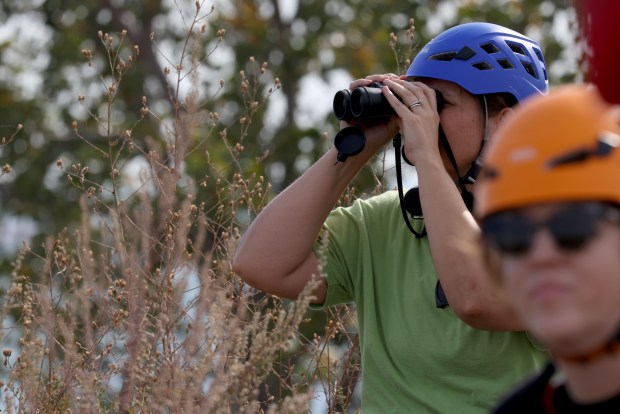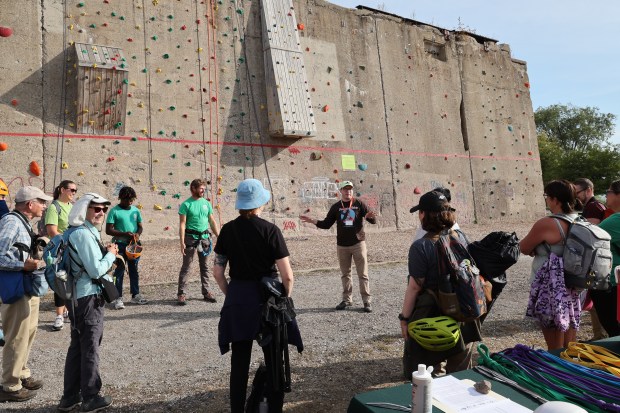Legs trembling ever so slightly, it took less than 3 minutes for 66-year-old Beth Genet to reach the top of a 30-foot rock climbing wall built on one of many historic concrete walls at Steelworkers Park in South Chicago. The ascent held the promise of an unimpeded view of hawks and other raptors flying along Lake Michigan’s south shore.
More than a dozen birders like Genet perched on the platform, binoculars in hand as they scanned the panoramic view, from the glittering water in the east to the hazy city skyline to the north. Graffitied ore walls from the former industrial site stand out among trees and prairie grass, showcasing how urbanization and nature have combined to make birdwatching in Chicago special and even unexpected.
The city’s first-ever Urban Birding Festival last weekend brought together a vibrant community of over 450 birders from Chicago and beyond to hear from expert speakers and explore prime locations during more than 100 guided field trips. At Steelworkers Park, more than 130 avian species were recorded over the three days. The events also highlighted the challenges of modifying existing buildings and constructing bird-friendly infrastructures in the middle of the country’s largest avian migratory route, the Mississippi Flyway.
Festival leaders and bird lovers hope that promoting birding opportunities in the city will lead more Chicagoans to develop a deeper appreciation for these winged creatures and subsequently fight for policy changes.
More than 300 species can be found in the Chicago area during fall migration, bird experts say.
“I think it always surprises people,” said Steve Pearson, 79, also looking out from atop the climbing wall Friday. He and his wife have been birding in the city since moving from the small village of Crete to Hyde Park in 2019, just before the pandemic started. Surprisingly, Pearson said, they didn’t notice much bird diversity when they lived in the country.
In and around Chicago, he likes heading out to the Chicago Park District’s Marian R. Byrnes Natural Area, the Sand Ridge Campus of the Forest Preserves of Cook County, and the lagoons, golf course and the Wooded Island in Jackson Park.
The morning came and went with no hawks on the horizon, but a good deal of Canada geese and ring-billed gulls, with the occasional gray catbird, double-crested cormorant, American crow and goldfinch. The group, equipped with boundless patience and a sharp eye for detail, remained optimistic.
“Well, hey — geese are birds!” Pearson chuckled.
They kept a faithful tally, calling out the names of every bird they sighted and heard, adding up 19 species at the end.
“It never gets old,” said Edward Warden, president of the Chicago Ornithological Society.
While the day was slow “as far birding goes,” Warden added, it was still a good start to the weekend’s festivities. His organization is planning another hawk watch at the Steelworkers climbing wall for the morning of Oct. 4.
On Sunday morning, another group gathered outside the Calumet Water Reclamation Plant at 400 E. 130th St. also on the Far South Side. Like the Steelworkers birding site, this one was characterized by the nearby whistling of passenger trains chugging along and, in the distance, Southwest Airlines planes taking off from Midway Airport.
With more than 50 years of expertise, group guide Geoff Williamson noted that while the location might seem like an unlikely birding spot to the uninitiated, water treatment facilities have become safe havens for certain bird species as erosion exacerbated by climate change — because of high water levels, intense storms and dwindling ice coverage — eats away at Lake Michigan’s sandy shorelines.
“The birders go where the birds are,” Williamson said, “and the birds are where there would be a habitat that’s appropriate.”
That day, the group recorded at least 42 species on the site, including osprey, American kestrels and red-tailed hawks. But the main attraction, and what the group had set out to find, were shorebird species of which they ultimately counted around two dozen.
“We saw that solitary sandpiper on that little muddy edge — that’s the kind of habitat that they like, and that sort of habitat is in very short supply in Cook County,” Williamson said. “So the sewage ponds, the settling ponds, make that sort of habitat in a sense.”

Located near the Calumet River in southeast Chicago, the facility sits atop marshy land where shorebirds can find small invertebrates to eat, and the plant’s lagoons are easier to forage in than a longer coastal mudflat by the lakeshore.
Serving a population of more than 1 million in the southern portion of Cook County, the 102-year-old Calumet wastewater treatment plant is the oldest of seven operated by the Metropolitan Water Reclamation District of Greater Chicago. While mudflats can have an eggy smell, the air at the plant can be much more concentrated because of its daily operations.
“There’s that smell — you just have to hold your breath,” said Williamson’s wife, Christine, determined to make the most of the outing regardless of the discomfort.
Before entering the plant to begin the tour, the group had already sighted a Cooper’s hawk, a peregrine falcon and a flock of monk parakeets — four bright green blurs flying parallel to some power lines. The latter, a South American species believed to be descendants of a flock that escaped in the 1970s from a shipment of pet birds at O’Hare International Airport, has long established nests in the nearby Hyde Park area and other parts of the city and suburbs
Inside the plant, most sewage lagoons open to the field trip were dried out, the bottom only a thick layer of cracked mud. But some had a few puddles where sandpipers teetered and killdeer bathed. A few ponds, more full and surrounded by common reeds, were alive with the sounds of insects and the calls of soras, snipes and waterthrush.
The group, from expert birders to amateurs of all ages, excitedly shared observations all morning. That diversity of experiences and backgrounds, festival organizers said, was also at the center of celebrations over the weekend. Leaders included members of Chicago BIPOC Birders, the Chicago Bird Alliance, the Chicago Ornithological Society, Feminist Bird Club Chicago, Red Hill Birding and the #citybirds project.
“Chicago is a global epicenter for birding — nothing beats birding here and that’s due to the vibrant birding community we have here,” said Zelle Tenorio of the Feminist Bird Club Chicago in an earlier news release. “We are long overdue for a festival to welcome all the new birders like me who began during the pandemic.”
On Friday at Steelworkers Park, Berwyn native Carolina Mayorja, 29, said she has been birdwatching since her teen years. That passion has spread to the rest of her family, including her immigrant parents, who she recently took to the Montrose Point Bird Sanctuary in Uptown — once the summer home of beloved Chicago piping plovers Monty and Rose and now of their son, Imani, and his new fledgling Nagamo.
“I just want to get involved with the birding community,” she said, “because I’ve cared about birds for a long time, and I want to get to know the people.”





